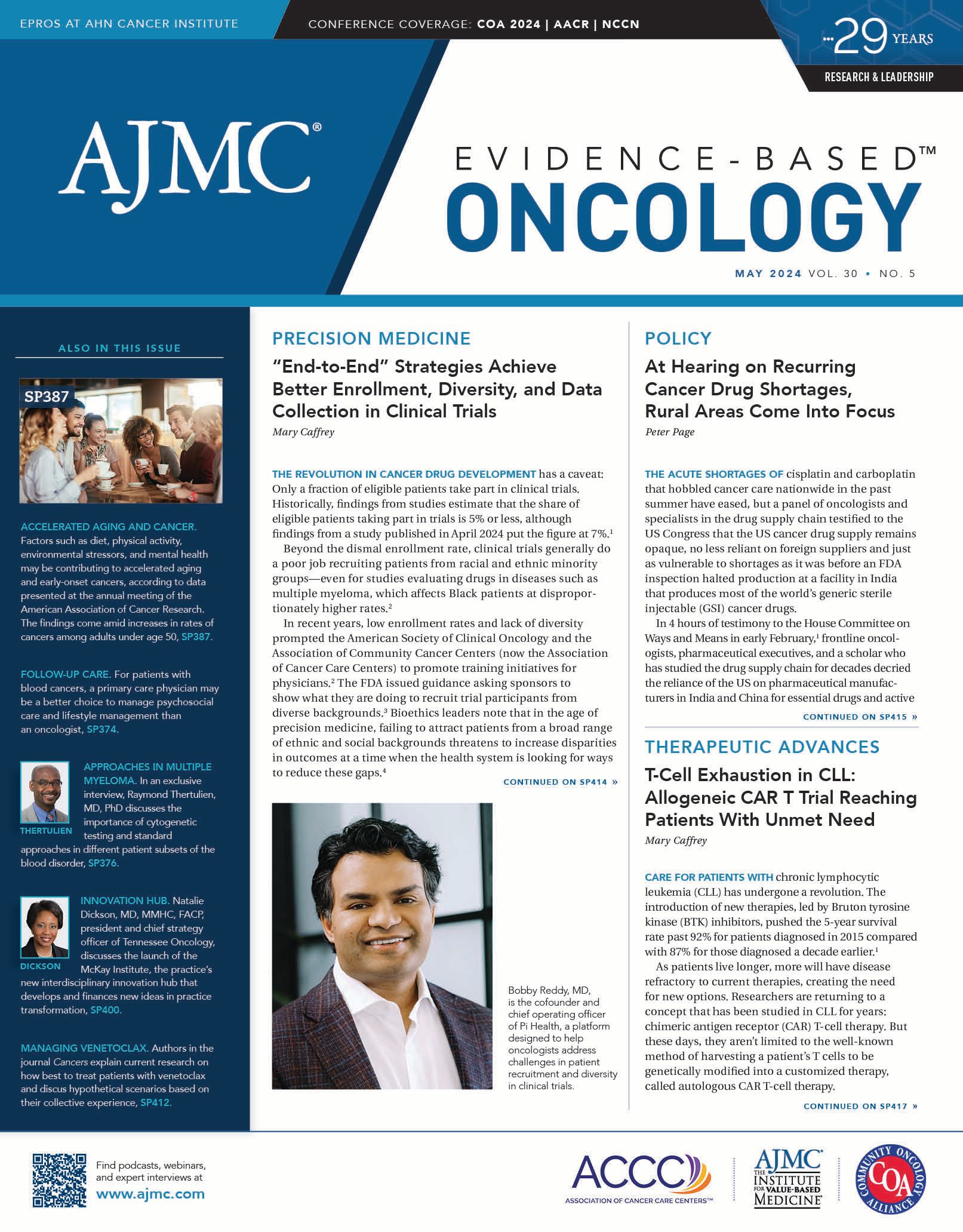- Center on Health Equity & Access
- Clinical
- Health Care Cost
- Health Care Delivery
- Insurance
- Policy
- Technology
- Value-Based Care
Follow-Up Needs for Blood Cancer Survivors May Determine Best Type of Provider
Differing characteristics of the patient and their disease may mean certain providers—academic oncologists, community oncologists, and primary care physicians—may be best suited for follow-up care.
For patients with blood cancers, follow-up care consisting of management of psychosocial consequences, promotion of a healthy lifestyle, and disease prevention may be better addressed by primary care physicians (PCPs) than oncologists, according to a study published in Cancer Medicine.
The study, conducted in Germany, found most survivors of blood cancers were receiving care at a university hospital and a minority were actually being care for by community oncologists or PCPs. The researchers evaluated follow-up care received by survivors from the University Hospital of Essen using a questionnaire.
Patient meeting with physician
Image credit: buritora - stock.adobe.com

“Given the favorable prognosis of many types of blood cancer, there is a wealth of information about long-term treatment side effects, secondary diseases, and quality of life. How and by whom follow-up care is delivered, however, remains largely unexplored,” the authors noted.
Follow-up can be provided in different ways. In one model, oncologists provide follow-up care related to cancer and general practitioners provide other health care at the same time. In another model, survivors of cancer are transferred to PCPs for continued care. In a more complex model, oncologists and general practitioners have complementary roles.
The prospective part of the Aftercare in Blood Cancer Survivors study compared follow-up institutions identified in an earlier retrospective part of the study and these follow-up physicians completed questionnaires that included information on the physician’s characteristics; the patient’s diagnosis, comorbidities, and follow-up frequency; and prospective document of disease detection, counseling for disease prevention, and more.
A total of 1551 patients consented to participate in the study and their conditions included monoclonal gammopathy of undetermined significance (MGUS), multiple myeloma (MM), indolent non-Hodgkin lymphoma including chronic lymphocytic leukemia, myelodysplastic syndrome, myeloproliferative neoplasms including chronic myeloid leukemia (MPN/CML), aggressive non-Hodgkin or Hodgkin lymphoma, and acute myeloid or acute lymphoblastic leukemia.
The patients named 1070 physician involved in follow-up care. While 72 named no follow-up physician, 729 named 1 physician, 706 named 2 physicians, and 44 named 3 physicians. Of the physicians named, 20.8% were hematologists or oncologists (referred to as oncologists), 34.2% were internists, 36.1% were general practitioners, and 8.9% were specialists in another field. Only 13.9% of the physicians worked in a hospital, while the rest were in private practice.
A little less than half (44.7%) of physicians named consented to participate in the questionnaire, and consent was highest among oncologists (53.4%) and lowest among specialists in other fields (16.8%). Physicians in group private practice were the most likely to participate (57.7%), while those in individual private practice were the least likely (34.3%).
Oncologists mostly relied on guidelines from the German Society of Hematology and Medical Oncology during follow-up, while internists and general practitioners tended to rely on information they received from physicians previously caring for the patients.
All groups said the most important goal of follow-up care was relapse detection followed by second primary malignancies. PCPs tended to believe follow-up care was more important than oncologists, and they also considered counseling for cancer screening, cardiovascular risk factors, and vaccination more important than oncologists. Overall counseling for disease prevention was done more extensively by PCPs.
On average, 2 follow-up visits were documented over the 18-month study period. During that time, 58 (8.1%) blood cancer relapses were reported, 47 (6.6%) cancer- or cancer therapy–related chronic diseases, 37 (5.2%) acute infections, 25 second primary malignancies, and 22 (3.1%) other noninfectious new diseases.
During the 18-month study, PCPs were more likely to report they consulted with patients on psychosocial issues, sexuality, and polyneuropathy. Academic oncologists were most likely to report consulting with patients on fertility and infection.
While patients with a high risk of relapse were mostly followed up at the university hospital, patients with stable condition who required continuous monitoring, such as those with MGUS, MM, and MPN/CML, were see most frequently by community oncologists. Those seen most by PCPs often had a history of curable disease and had long-term remission.
“Although the patients' needs appeared to be more comprehensively addressed by primary care physicians than by oncologists, one cannot conclude from our data that follow-up care should be shifted to the former,” the authors wrote, since a small proportion of patients were seen by PCPs. Those who were seen by PCPs were in stable remission, while the high-risk patients stayed with the university hospital.
A limitation of the study is selection bias regarding the PCPs included, who likely had “exceptional skills and motivations.” Another was the low number of documented follow-up visits outside of the university hospital, the variation in duration of follow-up, and the wide disease spectrum, all of which made comparisons difficult. The restriction of the study to a single comprehensive cancer center in Germany means the results may not apply to countries with other health care systems.
“Conclusions from the ABC study must be drawn with caution, because differences in the spectrum of hematological and secondary diseases among follow-up institutions precluded an unbiased comparison,” the authors wrote. However, they added “[for] patients with curable diseases in stable remission, transfer of follow-up care from oncologists to primary care providers seems feasible, provided the latter receive adequate information about the required procedures.”
Reference
Lax H, Baum J, Lehmann et al. Patterns of follow-up care in adult blood cancer survivors-Prospective evaluation of health-related outcomes, resource use, and quality of life. Cancer Med. 2024;13(7):e7095. doi:10.1002/cam4.7095

